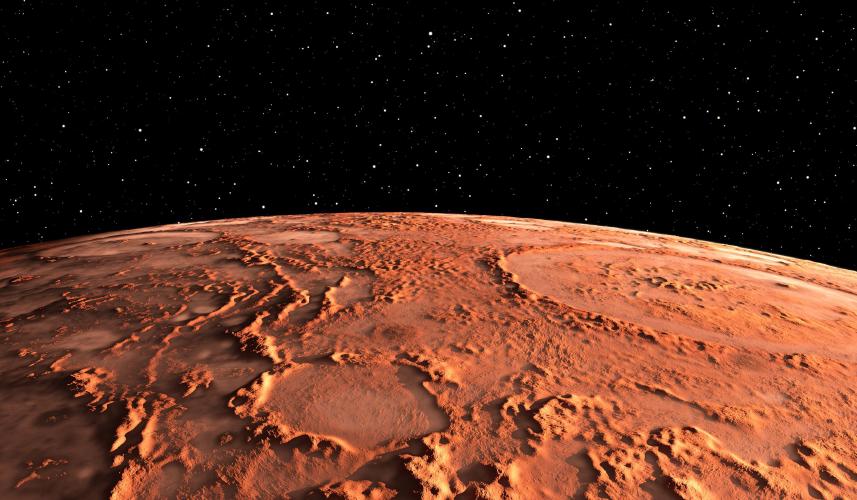Colonizing the Red Planet

The evening’s festivities have concluded. It is the dead of night, and you are walking back home. The sky is clear, and you decide to look up. There’s the moon, tranquil and calming as ever, illuminating your path with it’s light. And then, there’s something else. It’s small, and you never really noticed it before, or maybe you just never gave it much thought. But it’s there. A small red dot in the dark evening sky. Mars.
The red planet, and our planetary neighbor, Mars has been the subject of much discussion in recent years. In no small part to a certain billionaire’s stated obsession of getting there . Despite his, eccentricities, it is a valid goal however. Humans are aspirational. We have always been dedicated to the idea of “what if?” and pushing the boundaries of what is possible. It’s one of our species’ most inspiring traits. And for many, building a martian settlement is the next challenge for us to overcome. To colonize mars, to gain access to its resources , serve as a catalyst for future technological innovation, and (perhaps most importantly) turn the human race into space-faring civilization. Mars is only a stepping stone.
But before we can even think about reaping the benefits of a settlement on Mars, we still need to get there. However, the challenges don’t just stop at transporting people, we also have to think about feeding everyone, once we get there.
To understand how a settlement can be established on Mars, it helps to look back at history, and see how similar settlements were established in the “new world” by European colonizers. The Kurzgesagt youtube channel made a video that made this comparison (between space and colonial exploration). They broke up the establishment of a settlement into three phases.
| Phase | Description |
|---|---|
| Phase 1 | Exploration |
| Phase 2 | Initial settlements |
| Phase 3 | Thriving colonies |
In a nutshell, Phase 1 was about being able to chart out, and actually travel to the target land (or planet). In Phase 2, you then start to build up initial settlements. These settlements will attempt to produce what is necessary for their own survival. But they will still need support from their motherland. And then Phase 3, wherein the settlement manages to become self-sufficient, and starts sending wealth back towards the motherland.
For our eventual settlement of Mars, we are still in the process of Phase 1, but it is Phase 2 that could prove to be the ultimate challenge. For the one simple reason, that it is very difficult to grow food on Mars.
Contrary to what we may have seen on The Martian, growing potatoes on Mars isn’t as easy as adding poop to Martian soil. There are major obstacles to food growth, primarily they involve (1) an inhospitable atmosphere, (2) Martian soil devoid of nutrients, and (3) weak gravity (which negatively affects the plant growing process). Growing food on Mars is proving to be such a huge problem, that one scientist had even commented that it would be more energy efficient to simply transport food from Earth to Mars. Which, at its shortest, is a distance of at least 62.07 million kilometers, which only occurs once every two years .

The difficulty and near impossibility of growing food on Mars poses a challenge that humans have never really encountered in previous colonization attempts in history. As the Kurzgesagt channel suggested, once settlers arrive, and start Phase 2 of the colonial process, while the majority of colonies would fail, some would eventually succeed in building thriving settlements because they would eventually become self-sufficient food producers 1. This was in no small part because the land that they were colonizing, was a fertile, bountiful, and already capable of producing it’s own food (albeit not quite to European tastes). And these are note exactly similar conditions to what we see on Mars.
However, despite the challenges, not all hope is lost. Work is already being done to research means by which we can start to grow food on the red planet. Researchers are already identifying vegetables that would thrive on Mars2. Fields such as astrobiology are now focusing their efforts on identifying means by which humans can live on non-Earth planets.
The story of the human race has been one of overcoming hardship. Repeatedly we have faced challenges, roadblocks, and threats that make us question or own capability. But every time, we have said “No, we can overcome this.” And the journey of reaching Mars will be no different. We can overcome this, and we will.
This is part of my Random Writing Rodeo challenge. The topic was astronomy.
-
The ability for New World settlements to accomplish self-sufficiency was due in large-part to the practice of indentured servitude and slavery. It goes without saying that these practices are abhorrent, and have no place in a plant-spanning human civilization. The human race will settle Mars without the need to resorting to such barbarism. ↩︎
-
dandelions, microgreens, lettuce, arugula, spinach, peas, garlic, kale and onions. ↩︎



